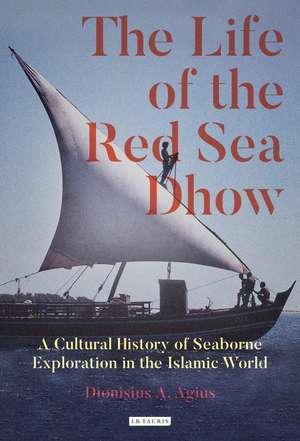The Life of the Red Sea Dhow: A Cultural History of Seaborne Exploration in the Islamic World
Autor Dionisius A. Agiusen Limba Engleză Paperback – 20 mar 2019
| Toate formatele și edițiile | Preț | Express |
|---|---|---|
| Paperback (1) | 207.54 lei 22-36 zile | |
| Bloomsbury Publishing – 20 mar 2019 | 207.54 lei 22-36 zile | |
| Hardback (1) | 572.73 lei 43-57 zile | |
| Bloomsbury Publishing – 20 mar 2019 | 572.73 lei 43-57 zile |
Preț: 207.54 lei
Preț vechi: 263.13 lei
-21% Nou
Puncte Express: 311
Preț estimativ în valută:
39.71€ • 41.57$ • 33.05£
39.71€ • 41.57$ • 33.05£
Carte disponibilă
Livrare economică 10-24 martie
Preluare comenzi: 021 569.72.76
Specificații
ISBN-13: 9781838603427
ISBN-10: 1838603425
Pagini: 384
Ilustrații: 63 bw and 8pp colour plates
Greutate: 0.84 kg
Editura: Bloomsbury Publishing
Colecția I.B.Tauris
Locul publicării:London, United Kingdom
ISBN-10: 1838603425
Pagini: 384
Ilustrații: 63 bw and 8pp colour plates
Greutate: 0.84 kg
Editura: Bloomsbury Publishing
Colecția I.B.Tauris
Locul publicării:London, United Kingdom
Caracteristici
Of interest to general readers as well as interdisciplinary appeal to scholars
Notă biografică
Dionisius A. Agius is Al Qasimi Professor of Arabic Studies and Islamic Material Culture at the University of Exeter. He is the author of numerous books including Seafaring in the Arabian Gulf and Oman (2005), winner of The Abdullah Al-Mubarak Al-Sabah Foundation and British-Kuwait Friendship Society Book Prize, and Class Ships of Islam (2008). He is a Fellow of the British Academy, the Royal Society of Arts and the Royal Geographical Society.
Recenzii
This a work of such scholarship and erudition that it should become a classic the second it is published. As a child sailing through the Red Sea on the army troop ships travelling to and from the Far East I have known and remembered these extraordinary and majestic boats. They sailed alongside us as we dropped anchor at Aden, circled us at Port Said and accompanied us through the Suez Canal. As old as time, and as pertinent today as they were before Abraham was born, these sturdy, graceful vessels did more than carry goods and people: they represented freedom, trade, exploration and endeavour, war and peace. Above all, they symbolize the interaction between Islam and the rest of the world; the publication of this book is timely indeed. A painting of dhows, reddened by the setting sun, hangs above my desk as I write. I can hear the creak of their timbers and the slap of the sails in my small study in London. Romantic, trustworthy, the dhow occupies a place in my heart reached by no other memory.
The strength of this book is its holistic approach and the wealth of invaluable information gathered by interviewing 166 people of various groups and ages . a significant source for students, researchers, and all those interested in the maritime cultures of the Red Sea and beyond.
This book represents an outstanding contribution on both the tangible and intangible maritime heritage of the Red Sea and constitutes an extraordinary tool for archaeologists and historians.
Reading this book, one has the feel of the sea: Dionisius Agius takes the reader aboard, shows how sailors lived and ate, where they went and what dangers they faced in the heat and wind of the Red Sea, observing the end of an era as the age-old sailing dhow gives way to fibre-glass and engine-power.
In this beautifully written study, Agius takes us on a journey through the rapidly vanishing world of traditional dhow and dhow voyaging. His exploration of this long-neglected subject relies on numerous informants and a wide-ranging array of important sources. This truly outstanding and definitive contribution to maritime history preserves priceless, vanishing traditional knowledge for future generations. A fascinating book to explore.
The strength of this book is its holistic approach and the wealth of invaluable information gathered by interviewing 166 people of various groups and ages . a significant source for students, researchers, and all those interested in the maritime cultures of the Red Sea and beyond.
This book represents an outstanding contribution on both the tangible and intangible maritime heritage of the Red Sea and constitutes an extraordinary tool for archaeologists and historians.
Reading this book, one has the feel of the sea: Dionisius Agius takes the reader aboard, shows how sailors lived and ate, where they went and what dangers they faced in the heat and wind of the Red Sea, observing the end of an era as the age-old sailing dhow gives way to fibre-glass and engine-power.
In this beautifully written study, Agius takes us on a journey through the rapidly vanishing world of traditional dhow and dhow voyaging. His exploration of this long-neglected subject relies on numerous informants and a wide-ranging array of important sources. This truly outstanding and definitive contribution to maritime history preserves priceless, vanishing traditional knowledge for future generations. A fascinating book to explore.
